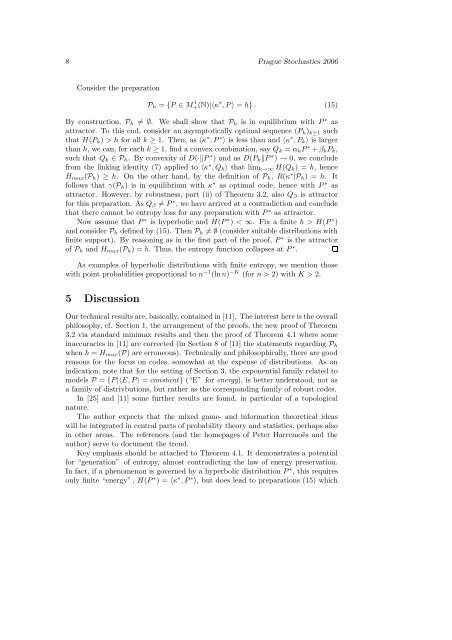Between Truth and Description
Between Truth and Description
Between Truth and Description
You also want an ePaper? Increase the reach of your titles
YUMPU automatically turns print PDFs into web optimized ePapers that Google loves.
8 Prague Stochastics 2006<br />
Consider the preparation<br />
Ph = {P ∈ M 1 + (N)|〈κ∗ , P 〉 = h} . (15)<br />
By construction, Ph �= ∅. We shall show that Ph is in equilibrium with P ∗ as<br />
attractor. To this end, consider an asymptotically optimal sequence (Pk)k≥1 such<br />
that H(Pk) > h for all k ≥ 1. Then, as 〈κ ∗ , P ∗ 〉 is less than <strong>and</strong> 〈κ ∗ , Pk〉 is larger<br />
than h, we can, for each k ≥ 1, find a convex combination, say Qk = αkP ∗ + βkPk,<br />
such that Qk ∈ Ph. By convexity of D(·�P ∗ ) <strong>and</strong> as D(Pk�P ∗ ) → 0, we conclude<br />
from the linking identity (7) applied to 〈κ ∗ , Qk〉 that limk→∞ H(Qk) = h, hence<br />
Hmax(Ph) ≥ h. On the other h<strong>and</strong>, by the definition of Ph, R(κ ∗ |Ph) = h. It<br />
follows that γ(Ph) is in equilibrium with κ ∗ as optimal code, hence with P ∗ as<br />
attractor. However, by robustness, part (ii) of Theorem 3.2, also Qβ is attractor<br />
for this preparation. As Qβ �= P ∗ , we have arrived at a contradiction <strong>and</strong> conclude<br />
that there cannot be entropy loss for any preparation with P ∗ as attractor.<br />
Now assume that P ∗ is hyperbolic <strong>and</strong> H(P ∗ ) < ∞. Fix a finite h > H(P ∗ )<br />
<strong>and</strong> consider Ph defined by (15). Then Ph �= ∅ (consider suitable distributions with<br />
finite support). By reasoning as in the first part of the proof, P ∗ is the attractor<br />
of Ph <strong>and</strong> Hmax(Ph) = h. Thus, the entropy function collapses at P ∗ .<br />
As examples of hyperbolic distributions with finite entropy, we mention those<br />
with point probabilities proportional to n −1 (ln n) −K (for n > 2) with K > 2.<br />
5 Discussion<br />
Our technical results are, basically, contained in [11]. The interest here is the overall<br />
philosophy, cf. Section 1, the arrangement of the proofs, the new proof of Theorem<br />
3.2 via st<strong>and</strong>ard minimax results <strong>and</strong> then the proof of Theorem 4.1 where some<br />
inaccuracies in [11] are corrected (in Section 8 of [11] the statements regarding Ph<br />
when h = Hmax(P) are erroneous). Technically <strong>and</strong> philosophically, there are good<br />
reasons for the focus on codes, somewhat at the expense of distributions. As an<br />
indication, note that for the setting of Section 3, the exponential family related to<br />
models P = {P |〈E, P 〉 = constant} (“E” for energy), is better understood, not as<br />
a family of distrivbutions, but rather as the corresponding family of robust codes.<br />
In [25] <strong>and</strong> [11] some further results are found, in particular of a topological<br />
nature.<br />
The author expects that the mixed game- <strong>and</strong> information theoretical ideas<br />
will be integrated in central parts of probability theory <strong>and</strong> statistics, perhaps also<br />
in other areas. The references (<strong>and</strong> the homepages of Peter Harremoës <strong>and</strong> the<br />
author) serve to document the trend.<br />
Key emphasis should be attached to Theorem 4.1. It demonstrates a potential<br />
for “generation” of entropy, almost contradicting the law of energy preservation.<br />
In fact, if a phenomenon is governed by a hyperbolic distribution P ∗ , this requires<br />
only finite “energy” , H(P ∗ ) = 〈κ ∗ , P ∗ 〉, but does lead to preparations (15) which

















